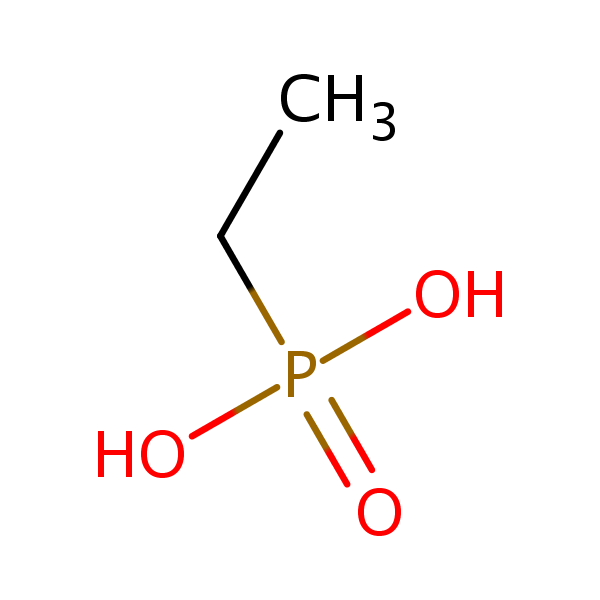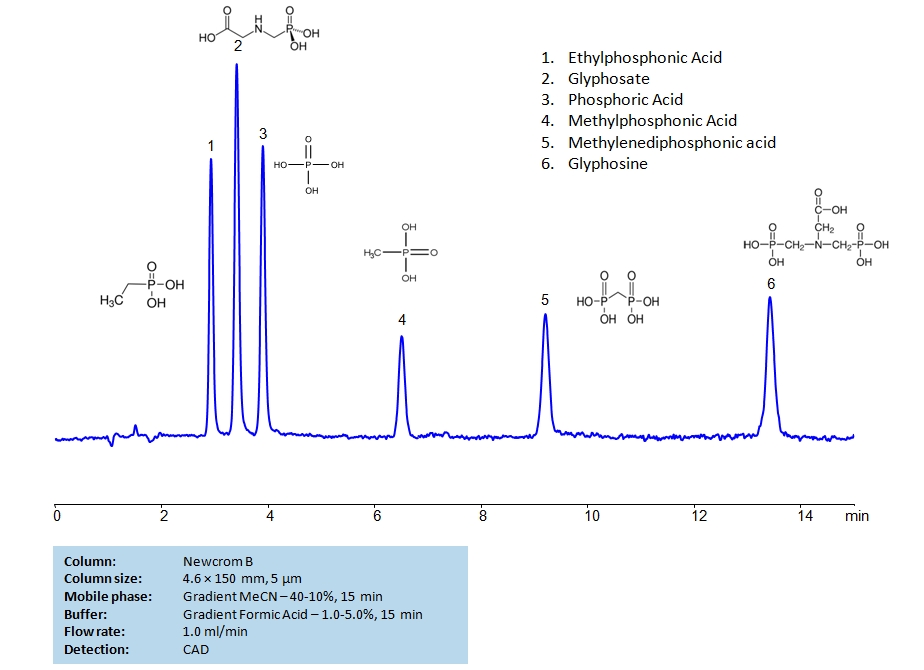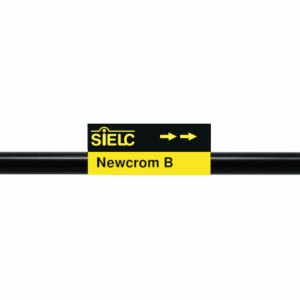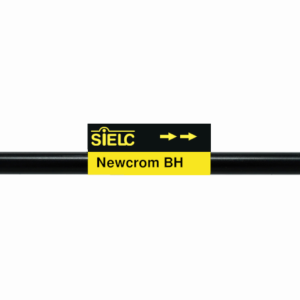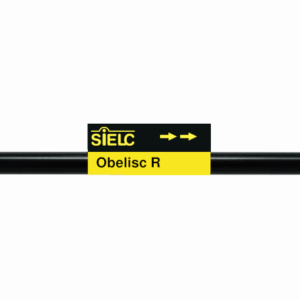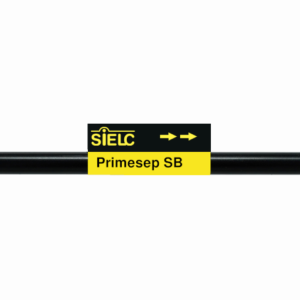| CAS Number | 6779-09-5 |
|---|---|
| Molecular Formula | C2H7O3P |
| Molecular Weight | 110.050 |
| InChI Key | GATNOFPXSDHULC-UHFFFAOYSA-N |
| LogP | -0.772 |
| Synonyms |
|
Applications:
UV-Vis Spectrum of Ethylphosphonic acid
December 23, 2025
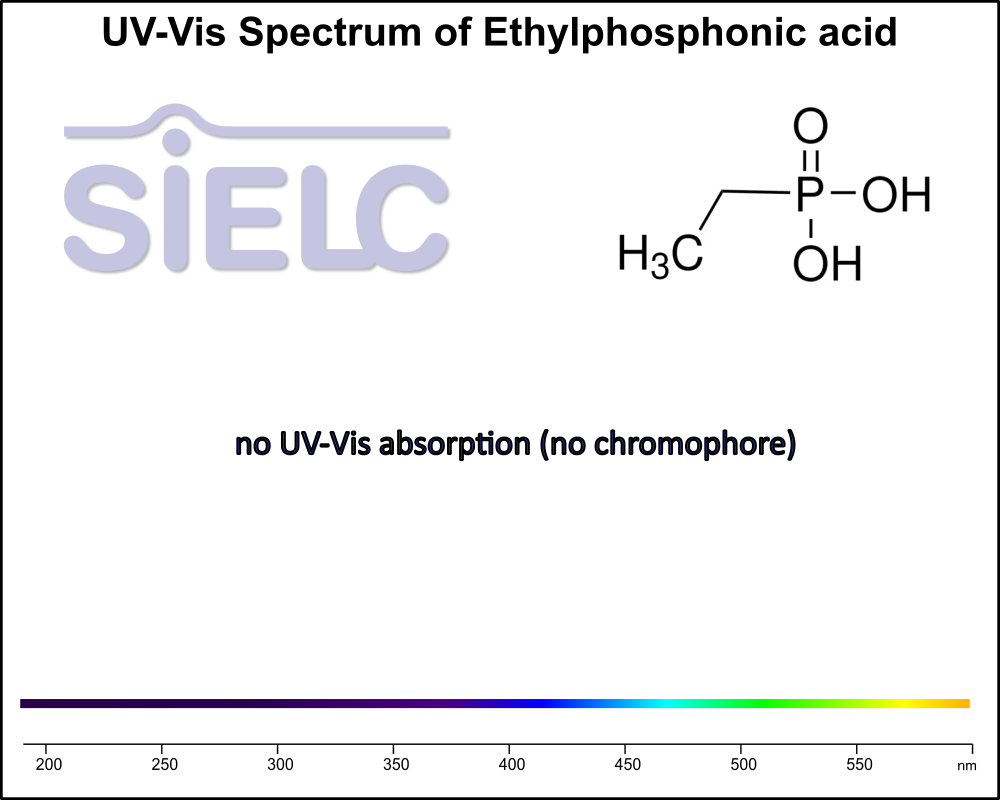
If you are looking for optimized HPLC method to analyze Ethylphosphonic Acid check our HPLC Applications library
For optimal results in HPLC analysis, it is recommended to measure absorbance at a wavelength that matches the absorption maximum of the compound(s) being analyzed. The UV spectrum shown can assist in selecting an appropriate wavelength for your analysis. Please note that certain mobile phases and buffers may block wavelengths below 230 nm, rendering absorbance measurement at these wavelengths ineffective. If detection below 230 nm is required, it is recommended to use acetonitrile and water as low UV-transparent mobile phases, with phosphoric acid and its salts, sulfuric acid, and TFA as buffers.
For some compounds, the UV-Vis Spectrum is affected by the pH of the mobile phase. The spectra presented here are measured with an acidic mobile phase that has a pH of 3 or lower.

HPLC Separation of Glyphosate, Glyphosine, Ethylphosphonic, Methylphosphonic, Methylenediphosphonic and Phosphoric Acids on Newcrom B Column
December 4, 2019
HPLC Method for Ethylphosphonic Acid, Methylphosphonic Acid, Glyphosate, Glyphosine, Methylenediphosphonic acid, Phosphate, Phosphoric Acid on Newcrom B by SIELC Technologies
High Performance Liquid Chromatography (HPLC) Method for Analysis of Ethylphosphonic Acid, Methylphosphonic Acid, Glyphosate, Glyphosine, Methylenediphosphonic acid, Phosphate, Phosphoric Acid.
Glyphosate is an herbicide with a chemical formula of C3H8NO5P. It works through blocking enzymes, like 5-enolpyruvylshikimate-3-phosphate synthase, essential for plant growth. It is typically found in agricultural work, but can occasionally be found in forestry and garden care.
Glyphosine is a synthetic plant growth regulator with the chemical formula of C4H11NO8P2. It is a colorless liquid that works through decreasing chlorophyll production.
Ethylphosphonic acid has a C2H5P(O)(OH)2 chemical formula. It is typically found as white crystals or crystalline powder. It is often used as an internal standard when researching fosfomycin in human plasma as well as a synthetic nucleotide analog.
Methylphosphonic acid is an organophosphorus compound with the chemical formula CH3P(OH)2. It is often used in some lubricant additives, textile treatments, and in synthesis of phosphonate compounds, like the previously mentioned Glyphosate.
Methylenediphosphonic acid has the chemical formula CH2[P(O)(OH)2]2. It is typically seen as a precursor in synthesis of Mesoporous aluminum organophosphate, if alkyltrimethylammonium, and Tetraester of methylenediphosphonic acids.
Phosphoric acid is an inorganic compound with chemical formula H3PO4. It is odorless and colorless, which leads to it’s common use in soft drunks to help preserve the product. It is also used in fertilizers, metal treatment, and corrosion inhibition. Excessive intake of it is not recommended.
Ethylphosphonic Acid, Methylphosphonic Acid, Glyphosate, Glyphosine, Methylenediphosphonic acid, Phosphate, Phosphoric Acid can be retained and analyzed using the Newcrom B stationary phase column. The analysis utilizes an isocratic method with a simple mobile phase consisting of water and acetonitrile (MeCN) with a formic acid buffer. Detection is performed using CAD.
| Column | Newcrom B, 4.6 x 150 mm, 5 µm, 100 A, dual ended |
| Mobile Phase | MeCN Gradient -40-10%, 15 min |
| Buffer | Formic Acid Gradient -1- 5%, 15 min |
| Flow Rate | 1.0 ml/min |
| Detection | CAD |
| Class of Compounds | Acids, Plant growth regulator, Herbicide, Hydrophilic, Ionizable |
| Analyzing Compounds | Ethylphosphonic Acid, Methylphosphonic Acid, Glyphosate, Glyphosine, Methylenediphosphonic acid, Phosphate, Phosphoric Acid |
Application Column
Newcrom B
Column Diameter: 4.6 mm
Column Length: 150 mm
Particle Size: 5 µm
Pore Size: 100 A
Column options: dual ended
Glyphosate
Glyphosine
Methylenediphosphonic acid
Methylphosphonic Acid
Phosphate
Phosphoric Acid

HPLC Separation of Glyphosate, Ethylphosphonic Acid and Methylphosphonic Acid on Newcrom B Column
December 2, 2019
HPLC Method for Methylphosphonic Acid, Ethylphosphonic Acid, Glyphosate, Phosphate on Newcrom B by SIELC Technologies
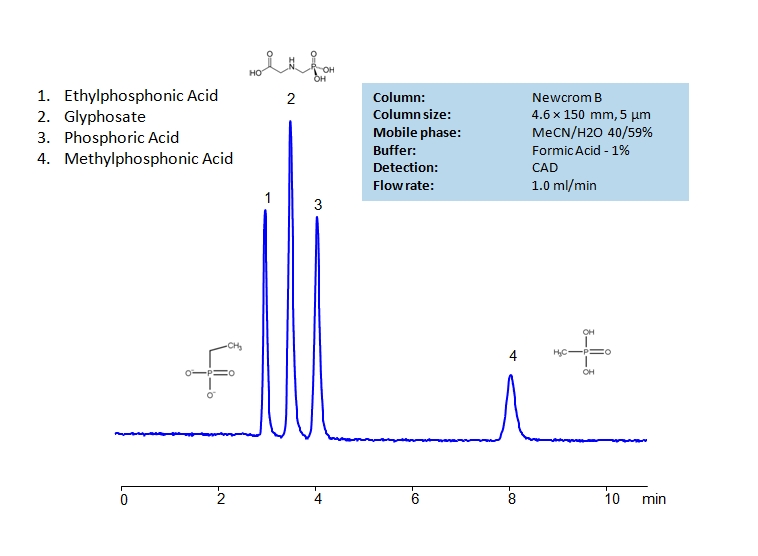 High Performance Liquid Chromatography (HPLC) Method for Analysis of Methylphosphonic Acid, Ethylphosphonic Acid, Glyphosate, Phosphate.
High Performance Liquid Chromatography (HPLC) Method for Analysis of Methylphosphonic Acid, Ethylphosphonic Acid, Glyphosate, Phosphate.
Ethylphosphonic acid has a C2H5P(O)(OH)2 chemical formula. It is typically found as white crystals or crystalline powder. It is often used as an internal standard when researching fosfomycin in human plasma as well as a synthetic nucleotide analog. Glyphosate is an herbicide with a chemical formula of C3H8NO5P. It works through blocking enzymes, like 5-enolpyruvylshikimate-3-phosphate synthase, essential for plant growth. It is typically found in agricultural work, but can occasionally be found in forestry and garden care.
Methylenediphosphonic acid has the chemical formula CH2[P(O)(OH)2]2. It is typically seen as a precursor in synthesis of Mesoporous aluminum organophosphate, if alkyltrimethylammonium, and Tetraester of methylenediphosphonic acids.
Phosphoric acid is an inorganic compound with chemical formula H3PO4. It is odorless and colorless, which leads to it’s common use in soft drunks to help preserve the product. It is also used in fertilizers, metal treatment, and corrosion inhibition. Excessive intake of it is not recommended.
Methylphosphonic Acid, Ethylphosphonic Acid, Glyphosate, Phosphate can be retained and analyzed using the Newcrom B stationary phase column. The analysis utilizes an isocratic method with a simple mobile phase consisting of water and acetonitrile (MeCN) with a formic acid buffer. Detection is performed using CAD.
| Column | Newcrom BH, 4.6 x 150 mm, 5 µm, 100 A, dual ended |
| Mobile Phase | MeCN/H2O – 40/59% |
| Buffer | Formic Acid – 1% |
| Flow Rate | 1.0 ml/min |
| Detection | CAD |
| Class of Compounds | Ions, Hydrophilic, Ionizable |
| Analyzing Compounds | Methylphosphonic Acid, Ethylphosphonic Acid, Glyphosate, Phosphate |
Application Column
Newcrom BH
Column Diameter: 4.6 mm
Column Length: 150 mm
Particle Size: 5 µm
Pore Size: 100 A
Column options: dual ended
Glyphosate
Methylphosphonic Acid
Phosphate

HPLC Separation of Ethylphosphonic, Methylphosphonic, Methylenediphosphonic and Phosphoric Acids on Newcrom B Column
December 2, 2019
HPLC Method for Ethylphosphonic Acid, Methylphosphonic Acid, Methylenediphosphonic acid, Phosphate, Phosphoric Acid on Newcrom B by SIELC Technologies  High Performance Liquid Chromatography (HPLC) Method for Analysis of Ethylphosphonic Acid, Methylphosphonic Acid, Methylenediphosphonic acid, Phosphate, Phosphoric Acid
High Performance Liquid Chromatography (HPLC) Method for Analysis of Ethylphosphonic Acid, Methylphosphonic Acid, Methylenediphosphonic acid, Phosphate, Phosphoric Acid
Ethylphosphonic acid has a C2H5P(O)(OH)2 chemical formula. It is typically found as white crystals or crystalline powder. It is often used as an internal standard when researching fosfomycin in human plasma as well as a synthetic nucleotide analog. Glyphosate is an herbicide with a chemical formula of C3H8NO5P. It works through blocking enzymes, like 5-enolpyruvylshikimate-3-phosphate synthase, essential for plant growth. It is typically found in agricultural work, but can occasionally be found in forestry and garden care.
Methylphosphonic acid is an organophosphorus compound with the chemical formula CH3P(OH)2. It is often used in some lubricant additives, textile treatments, and in synthesis of phosphonate compounds, like the previously mentioned Glyphosate.
Methylenediphosphonic acid has the chemical formula CH2[P(O)(OH)2]2. It is typically seen as a precursor in synthesis of Mesoporous aluminum organophosphate, if alkyltrimethylammonium, and Tetraester of methylenediphosphonic acids. Ethylphosphonic Acid, Methylphosphonic Acid, Methylenediphosphonic acid, Phosphate, Phosphoric Acid can be retained and analyzed using the Newcrom B stationary phase column. The analysis utilizes an isocratic method with a simple mobile phase consisting of water and acetonitrile (MeCN) with a formic acid buffer. Detection is performed using CAD.
| Column | Newcrom BH, 4.6 x 150 mm, 5 µm, 100 A, dual ended |
| Mobile Phase | MeCN/H2O – 20/78% |
| Buffer | Formic Acid – 2% |
| Flow Rate | 1.0 ml/min |
| Detection | CAD |
| Class of Compounds | Acids, Hydrophilic, Ionizable |
| Analyzing Compounds | Ethylphosphonic Acid, Methylphosphonic Acid, Methylenediphosphonic acid, Phosphate, Phosphoric Acid |
Application Column
Newcrom BH
Column Diameter: 4.6 mm
Column Length: 150 mm
Particle Size: 5 µm
Pore Size: 100 A
Column options: dual ended
Methylenediphosphonic acid
Methylphosphonic Acid
Phosphate
Phosphoric Acid

Effect of pH on Separation of Glyphosate and Ethylphosphonic Acid
July 8, 2011
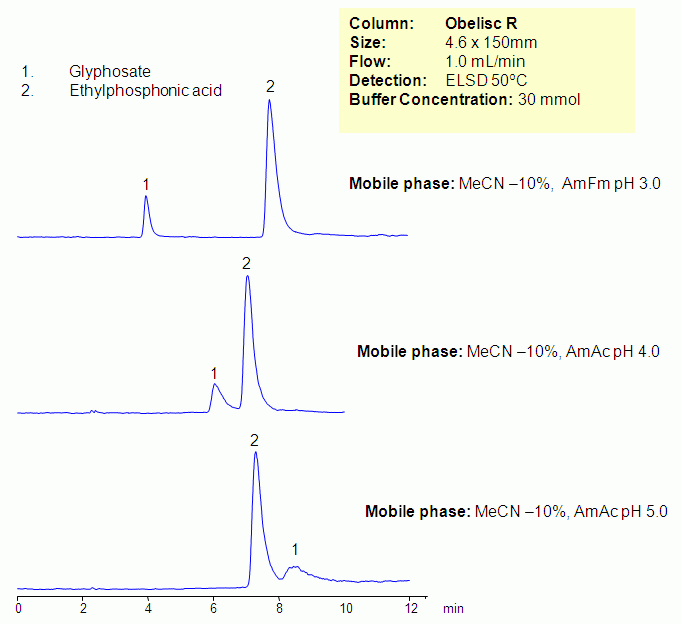
Glyphosate is broad spectrum herbicide to kill weeds. Presence of glyphosate in water, fruits and veggies is regulated. Alkylphosphonic acids are decomposition byproducts of chemical warfare agents. Analysis of phosphonic acid in water is regulated by Environmental Protection Agency (EPA). All phosphonic acids are polar acidic compounds. Method was developed for glyphosate and ethylphosphonic acid. Both compounds are retained by ion-exchange mechanism. Method is compatible with LC/MS and can be used for analysis of glyphosate and alkylphosphonic acids in various matrices.
| Column | Obelisc R, 4.6×150 mm, 5 µm, 100A |
| Mobile Phase | MeCN – 10% |
| Buffer | AmAc |
| Flow Rate | 1.0 ml/min |
| Detection | ELSD 50C |
<
| Class of Compounds |
Insecticide, Herbicide, Fungicide, Hydrophobic, Ionizable |
| Analyzing Compounds | Glyphosate, Ethylphosphonic acid |
Application Column
Obelisc R
SIELC has developed the Obelisc™ columns, which are mixed-mode and utilize Liquid Separation Cell technology (LiSC™). These cost-effective columns are the first of their kind to be commercially available and can replace multiple HPLC columns, including reversed-phase (RP), AQ-type reversed-phase, polar-embedded group RP columns, normal-phase, cation-exchange, anion-exchange, ion-exclusion, and HILIC (Hydrophilic Interaction Liquid Chromatography) columns. By controlling just three orthogonal method parameters - buffer concentration, buffer pH, and organic modifier concentration - users can adjust the column properties with pinpoint precision to separate complex mixtures.
Select optionsGlyphosate

HPLC Separation of Methylphosphonic Acid and Related Products
October 14, 2010
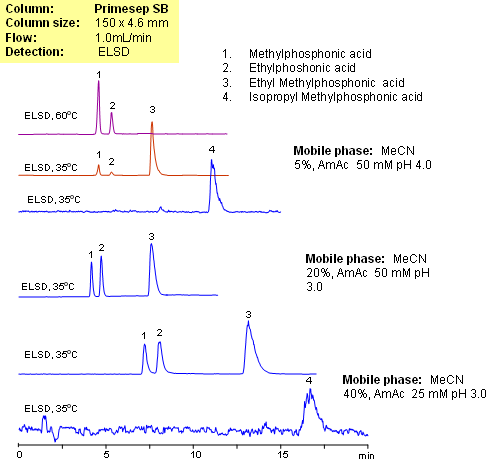
Alkylphosphonic acids are decomposition byproducts of chemical warfare agents. Analysis of phosphonic acid in water is regulated by Environmental Protection Agency (EPA). All phosphonic acids are polar acidic compounds. Analysis for retention and separation of methylphosphonic, ethylphosphonic, ethyl methylphosphonic and isopropyl methylphosphonic acids was developed using Primesep SB reversed-phase anion-exchange column. Method is compatible with LC/MS and can be used for quantitation of phosphonic acid in water.
| Column | Primesep SB, 4.6×150 mm, 5 µm, 100A |
| Mobile Phase | MeCN |
| Buffer | AmAc |
| Flow Rate | 1.0 ml/min |
| Detection | ELSD |
<
| Class of Compounds |
Acid, Hydrophilic, Ionizable |
| Analyzing Compounds | Methylphosphonic, Ethylphosphonic, Ethyl methylphosphonic, Isopropyl methylphosphonic acids |
Application Column
Primesep SB
The Primesep family of mixed-mode columns offers a wide variety of stationary phases, boasting unprecedented selectivity in the separation of a broad array of chemical compounds across multiple applications. Corresponding Primesep guard columns, available with all stationary phases, do not require holders. SIELC provides a method development service available to all customers. Inquire about our specially-tailored custom LC-phases for specific separations.
Select optionsEthylphosphonic Acid
Isopropyl Methylphosphonic Acid
Methylphosphonic Acid

